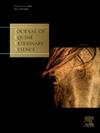Addition of a motility stimulant improves kinetic parameters in post-thawed cholesterol-loaded stallion semen
IF 1.3
3区 农林科学
Q2 VETERINARY SCIENCES
引用次数: 0
Abstract
The freezing process exposes sperm to thermal stress, resulting in structural damage that may compromise their functionality. This study aimed to assess the impact of including cholesterol bound to cyclodextrin (CLC) before cryopreservation and of adding a motility stimulant (FertTalp) (Parrish et al. Theriogenology. 1986; 25:591-600) after thawing, on sperm kinetics, intracellular hydrogen peroxide production, mitochondrial potential and plasma membrane destabilization in equine semen. Twelve Mangalarga Marchador stallions were used to collect two ejaculates each, subsequently divided into four experimental groups: G1 (no CLC), G2 (1 mg CLC), G3 (1.5 mg CLC) and G4 (2 mg CLC). In Experiment I, the semen was cryopreserved according to Papa et al. (Animal Reproduction Science. 2008; 107:293-301), and sperm kinetics, mitochondrial potential and membrane destabilization were evaluated after thawing at 37°C. In Experiment II, the same parameters were evaluated after addition of FertTalp after thawing (20% v/v), as well as the evaluation of intracellular hydrogen peroxide production and a thermo-resistance test (TTR) to verify semen longevity for 120 minutes. Statistical analysis was performed using the F test, Tukey, Friedman and Conover, significance 5%. The results of Experiment I indicated that group G3 (1.5 mg CLC) showed higher total motility (TM) and progressive motility (PM) than group G1 (without CLC) (P<0.05), suggesting that this concentration of cholesterol is efficient in maintaining the kinetic quality of sperm after thawing. There were no significant differences between the groups regarding mitochondrial potential and plasma membrane destabilization. In Experiment II, addition of FertTalp post-thawing resulted in a significant increase in sperm velocity parameters (VCL, VSL, VAP) after 80 minutes of thawing, when compared to groups without FertTalp. The addition of the stimulant also favoured plasma membrane integrity and reduced intracellular hydrogen peroxide production, indicating that FertTalp was beneficial in preserving cell functionality during the thawing process. Data from the TTR showed that, over time (0 to 120 minutes), groups with FertTalp addition maintained higher motility and superior sperm velocity parameters when compared to other groups. These results suggest that the addition of CLC at a concentration of 1.5 mg before cryopreservation can improve sperm quality after thawing, especially concerning the motility. Furthermore, the addition of FertTalp as a post-thaw motility stimulant provides additional benefits, especially in preserving velocity and cellular integrity over time. In conclusion, the addition of CLC is beneficial for improving sperm motility after cryopreservation, and the use of FertTalp provides additional advantages in maintaining sperm quality during thawing and subsequent incubation, promoting greater sperm longevity and viability.
求助全文
约1分钟内获得全文
求助全文
来源期刊

Journal of Equine Veterinary Science
农林科学-兽医学
CiteScore
2.70
自引率
7.70%
发文量
249
审稿时长
77 days
期刊介绍:
Journal of Equine Veterinary Science (JEVS) is an international publication designed for the practicing equine veterinarian, equine researcher, and other equine health care specialist. Published monthly, each issue of JEVS includes original research, reviews, case reports, short communications, and clinical techniques from leaders in the equine veterinary field, covering such topics as laminitis, reproduction, infectious disease, parasitology, behavior, podology, internal medicine, surgery and nutrition.
 求助内容:
求助内容: 应助结果提醒方式:
应助结果提醒方式:


